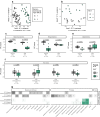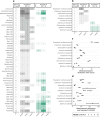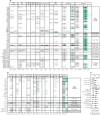Protozoal populations drive system-wide variation in the rumen microbiome
- PMID: 40623969
- PMCID: PMC12234698
- DOI: 10.1038/s41467-025-61302-2
Protozoal populations drive system-wide variation in the rumen microbiome
Abstract
While rapid progress has been made to characterize the bacterial and archaeal populations of the rumen microbiome, insight into how they interact with keystone protozoal species remains elusive. Here, we reveal two distinct system-wide rumen community types (RCT-A and RCT-B) that are not strongly associated with host phenotype nor genotype but instead linked to protozoal community patterns. We leveraged a series of multi-omic datasets to show that the dominant Epidinium spp. in animals with RCT-B employ a plethora of fiber-degrading enzymes that present enriched Prevotella spp. a favorable carbon landscape to forage upon. Conversely, animals with RCT-A, dominated by genera Isotricha and Entodinium, harbor a more even distribution of fiber, protein, and amino acid metabolizers, reflected by higher detection of metabolites from both protozoal and bacterial activity. Our results indicate that microbiome variation across key protozoal and bacterial populations is interlinked, which should act as an important consideration for future development of microbiome-based technologies.
© 2025. The Author(s).
Conflict of interest statement
Competing interests: Authors P.B.P., G.W.T., S.J.M. and A.L. have stock and/or equity interests in Bovotica Pty Ltd. R.D.W. and M.T.S. are employed at Cmbio, which provides consulting and sequencing services. The remaining authors declare no competing interests.
Figures





References
-
- Beauchemin, K. A., Ungerfeld, E. M., Eckard, R. J. & Wang, M. Review: Fifty years of research on rumen methanogenesis: lessons learned and future challenges for mitigation. Animal14, s2–s16 (2020). - PubMed
-
- Storm, A. C., Kristensen, N. B. & Hanigan, M. D. A model of ruminal volatile fatty acid absorption kinetics and rumen epithelial blood flow in lactating Holstein cows. J. Dairy Sci.95, 2919–2934 (2012). - PubMed
MeSH terms
Grants and funding
- 0054575-SuPAcow/Novo Nordisk Fonden (Novo Nordisk Foundation)
- No.101000213/EC | EU Framework Programme for Research and Innovation H2020 | H2020 Priority Excellent Science | H2020 European Research Council (H2020 Excellent Science - European Research Council)
- FT230100560/Department of Education and Training | Australian Research Council (ARC)
LinkOut - more resources
Full Text Sources
Miscellaneous

